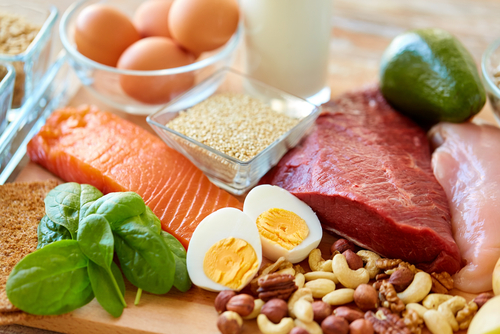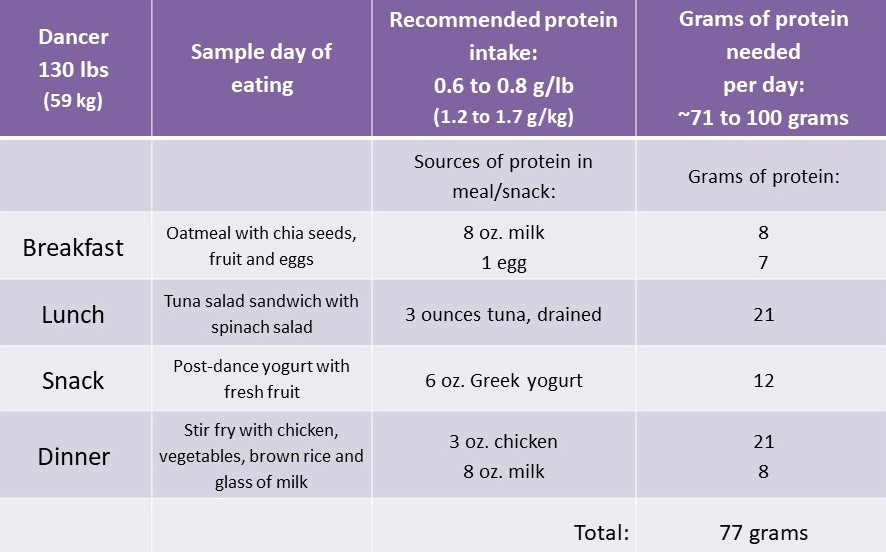Dance Talk
Our dance season never ends. Learn dance tips from the best.
Powering Dance with Protein

Powering Dance with Protein
High quality protein is an essential part of any athlete's diet. For a dancer's body to adapt, get stronger and see improvements in their skills and performance, a winning nutrition plan needs to include adequate intake each day along with with proper refueling with carbohydrates, rehydrating with fluids, and repairing the body with protein-containing foods.
What is the function of protein?
Prolonged and rigorous dance training places significant demands on the body. For a dancer, the primary goal for consuming protein is for muscle growth and to repair the muscle fibers that are stressed by constant use during dance. Protein also has a key role in bone health, repair of red blood cells, regulation of hormones, digestion, protection against disease and carrying oxygen to tissues. Protein can also supply small amounts of energy for dancing and other activities from breaking down muscle tissue when carbohydrate stores are depleted. Obviously, this is an undesirable consequence for the dancer trying to maintain his or her muscle tissue, and an important reason to ensure adequate intake that includes carbohydrate foods (fruits, veggies, grains) for fueling dance.
Not all protein is created equal.
The amino acid is the building block of all proteins found in both plant and animal foods. Of the 20 amino acids that form proteins, 9 are considered "essential" and need to be obtained from the diet. Animal sources of protein (meat, poultry, fish, dairy products, and eggs) are considered a "high quality" protein because they provide all of these essential amino acids (EAAs). Except for soy, quinoa, and buckwheat, plant based proteins (beans, grains, nuts and seeds) do not have all the EAAs. For dancers who choose to avoid consuming animal protein, eating a variety of plant-based foods is essential to provide all the EAAs needed.
How much protein do I need each day?
Highly active individuals and dancers in training need more protein than sedentary folks and the amount of protein needed daily varies by intensity and duration of activity. Daily protein needs are based on body weight, with a general recommendation for dancers around 0.6 to 0.8 grams per pound (g/lb). Dancers who are recovering from an injury or young dancers and adolescents who are still growing may require up to 1 g/lb. Protein consumption greater than 1 g/lb daily is not recommended for a variety of reasons, including it is often at the expense of achieving carbohydrate goals, and there is a lack of scientific evidence that a higher intake is more effective. To maximize muscle growth and repair, consume around 20 grams of protein after dancing and at each meal -- so about every 4 hours. (20 grams of protein is the equivalent of a palm-sized serving of meat, pork or poultry; one cup of tofu; one cup of beans or 6 oz Greek yogurt with a couple tablespoons of almonds).
Does timing of intake matter?
A common misunderstanding among many dancers and athletes is that a large amount of protein at one time is most beneficial. Evidence suggests that this theory is incorrect (Moore, et al. Am J Clin Nutr, 2009). Rather, researchers have demonstrated that the body continues to repair and recover several hours after activity. Therefore, dancers need to distribute their protein intake evenly throughout the day by including high quality protein at each of their meals and snacks (Schoenfeld, et al. J Intl Sports Nutr, 2013).
A simple example for calculating your protein needs: When trying to determine how much protein a dancer needs each day, divide your weight in half. Use that number as your baseline or low end for how many grams of protein you will consume each day (Note: my experience has been that most athletes are already consuming more than this number). Consider the amount of training you are currently doing. When you are approaching performance or competition season, the upper end of your daily protein requirement may be needed which is approximately one gram per pound of body weight. You then want to try and spread out your protein intake across your meals and snacks, aiming for about 20 grams of protein at each meal and making up the rest in your snacks. So, if you are shooting for about 80 grams of protein per day, and you eat 3 meals and 2 snacks (with 20 grams protein per meal), then try to include a minimum of 10 grams of protein at each of your snacks.

Food can easily provide adequate protein to meet a dancer's protein needs. In this table, we see how a dancer's daily protein needs can easily be met by consuming adequate amounts of high quality protein at each of three nutritionally balanced meals and one snack.
About the Author: Val Schonberg is a Registered, Licensed Dietitian with a Master's degree in nutrition science and Board Certified as a Specialist in Sports Nutrition. She is the founder of EnlightenU Nutrition Consulting and enjoys enlightening individuals about food, eating and overall wellness. For questions or additional information, you can check out her website at www.enlightenUnutrition.com or contact Val directly at 612-865-6813.

Follow Us
Follow Us online, join our conversations, engage with our teams around the world!